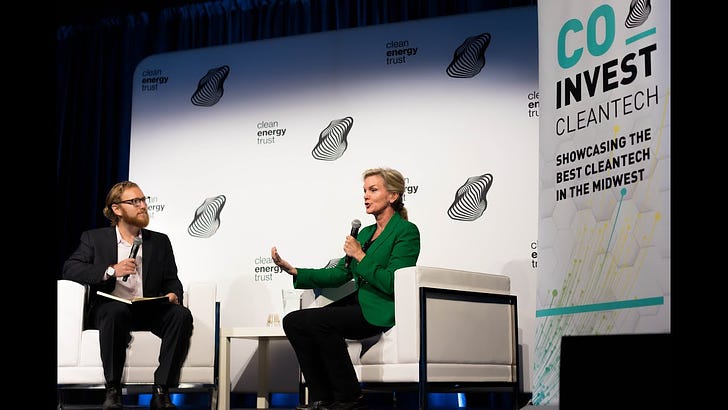An Energy Secretary Who Knows What Clean Energy Can Do
Welcome to Bright Ideas, a weekly newsletter on the rise of clean energy. I’m the author, Julian Spector. I report on the clean energy industry for Greentech Media, but not for long. I do Bright Ideas for fun, just to feel a sense of agency. I normally send it out Tuesday mornings, but this week, I was busy with some things.
Subscribe for free here if you haven’t yet, the ROI is outstanding.
Remember your buddy who keeps saying “but what’s up with clean energy, my dude?” Be a good friend. Share Bright Ideas.
Normally I deliver clean energy insights via the written word. Today, Bright Ideas is breaking the sound barrier. Behold, our first ever ~special audio edition~ for a very good reason.
Last week, the Senate confirmed former Michigan Gov. Jennifer Granholm as the new U.S. Energy Secretary. Her job, besides all the wonky nuclear nonproliferation stuff, is to slam the accelerator on clean energy adoption to fight climate change and a massive recession simultaneously. It would be a stellar time to hear her candidly explain how she thinks about these precise issues.
Those readers who know me personally can attest that I’m nothing if not punctual, and here, I outdid myself. I interviewed Granholm three years ahead of schedule. It happened on a stage in Chicago, at an event hosted by the Clean Energy Trust. The good folks over there rustled up the audio recently, and I encourage you to take a listen. I’ve embedded the YouTube video below, which includes a slideshow featuring me with shorter, pre-quarantine beard and hair.
As you’ll hear, Granholm turned to clean energy not as a science project, but as a means of saving her state’s economy when the Great Recession tanked the auto industry. She and her team analyzed all the most likely pathways to grow new jobs, and electric vehicles and the batteries that power them rose to the top of the list.
Real talk on green jobs:
The rosy discourse around “green jobs” often glosses over real complexities. Planning a smooth energy transition requires leaders who honestly confront the jobs that will be lost in the process.
Granholm starts (around 13:20) by acknowledging “the fear of those who feel like the world is leaving them behind.”
“The emphasis on miners and on coal workers, I think we cannot lose sight of the human beings that are behind that. Donald Trump has something right in this, which is people have a livelihood and for generations they may have worked at this place and have felt totally identified and connected…
We’ve just got to be super careful about respecting the dignity of these workers and providing them an opportunity.”
The emotional stakes really ramp up at 15:00, when Granholm recounts visiting an appliance factory’s “Last Supper” before it shuts down. A worker recognizes her and approaches:
“He says, ‘I want you to meet my two daughters.’ And he pulls his young, teenage daughters next to him. And he says, ‘These girls have seen me work at this factory. I worked at this factory since I was 18 years old. I've been there for 30 years, I'm now 48 years old. My father worked at this factory. My grandfather worked at this factory.
‘All I know,’ he said, ‘is how to make refrigerators.’ And then he looks at his girls, and he puts his hand on his chest like this. ‘So governor, tell me, who is ever going to hire me?’”
We dug into how you actually provide that kind of opportunity, because simply talking about “jobs programs” does not suffice.
Michigan paid 200,000 workers to train for new roles in the specific areas that had been selected as strategic growth areas, including clean energy (this comes around 19:30). But Granholm advises siting such training programs at actual workplaces, so people are getting paid to learn jobs they can actually fill.
She also has advice for how states can cultivate clean energy jobs that maximize their existing skillsets and resources, rather than trying to replicate wind and solar everywhere.
What comes next?
Proactive state leadership can make a huge difference in preparing for the energy shifts that are already underway.
What’s less clear is how much Granholm can do as DOE Secretary to address these issues. The DOE can’t tell states how to run their jobs training. Its function in the clean energy world is largely to disburse grants and loans to people who develop and install new technologies.
But the federal platform offers new kinds of authority, and Granholm as a politician may choose to exercise that more emphatically than some of the academics and scientists that occupied the post in the past (no offense to academics and scientists).
At the very least, she can speak from experience that it’s better to prepare for the change than wait for it to hit you. While coal plants shut down, Detroit’s electric vehicle lines are ramping up.
This week in quarantine: Watch Minari
What a time to be alive, when MoviePass bestows unlimited cinematic bounty one year, and the next, all cinemas shut down.
I’ve been missing that experience almost as much as I miss the saunas of L.A.’s Wi Spa. But I got a taste of theatergoing last week with a timed screening of Minari. This film crushed it at Sundance last year, then wasn’t released because of COVID, then became available in time-limited virtual screening slots from studio A24.
A movie where you have to get in your seat by a certain time and can’t just nosh on takeout and sip natural wine all night long is the closest thing to discipline I’ve felt in a long time.
Now, apparently, you can stream it whenever you want for $20, so if you follow this recommendation you’ll be subjected to complete temporal freedom. Alas.
In any case, the film itself is terrific, following a Korean-American family that settles in rural Arkansas to work at a chicken facility and farm their own land. Hollywood’s immigrant stories tend to converge on coastal cities; here, you get absolutely saturated in the green fronds of the fields. Several times I had to check if the symphony of crickets had somehow penetrated my home, until a scene change brought some fresh audiovisual immersion.
Another standout feature was how the narrative brings you inside the minds of both parents and child. It’s neither a “kid grows up” story nor a “parents deal with their issues” story. It’s both, in a totally balanced way. Plus there’s a badass grandma who shakes things up.
Lastly, it’s set several decades ago, so it checks the boxes of appropriately distant in time and space to escape from our present predicament.







